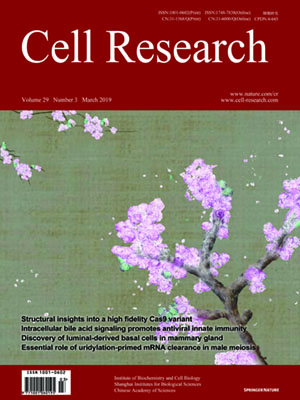
Volume 29, No 3, Mar 2019
ISSN: 1001-0602
EISSN: 1748-7838 2018
impact factor 17.848*
(Clarivate Analytics, 2019)
Volume 29 Issue 3, March 2019: 221-232 | Open Access
ORIGINAL ARTICLES
A programmed wave of uridylation-primed mRNA degradation is essential for meiotic progression and mammalian spermatogenesis
Marcos Morgan 1,2,3, Yuka Kabayama 1,3, Christian Much 1,2, Ivayla Ivanova 1, Monica Di Giacomo 2, Tatsiana Auchynnikava 3, Jack Michael Monahan 4, Dimitrios Michael Vitsios 4, Lina Vasiliauskaitė 1,2, Stefano Comazzetto 2, Juri Rappsilber 3,5, Robin Campbell Allshire 3, Bo Torben Porse 6,7,8, Anton James Enright 4 and Dónal O’Carroll 1,3
1 MRC Centre for Regenerative Medicine, School of Biological Sciences, University of Edinburgh, 5 Little France Drive, Edinburgh EH16 4UU, UK; 2 European Molecular Biology Laboratory (EMBL), Via Ramarini 32, 00015 Monterotondo, Italy; 3Wellcome Centre for Cell Biology, University of Edinburgh, Edinburgh EH9 3BF, UK; 4 European Bioinformatics Institute, Hinxton, Cambridge CB10 1SD, UK; 5 Institute of Biotechnology, Technische Universität Berlin, Berlin 13355, Germany; 6 Biotech Research and Innovation Center (BRIC),
University of Copenhagen, Copenhagen 2200, Denmark; 7 The Finsen Laboratory, Rigshospitalet, Faculty of Health Sciences, University of Copenhagen, Copenhagen 2200, Denmark and 8Danish Stem Cell Centre (DanStem), Faculty of Health Sciences, University of Copenhagen, Copenhagen 2200, Denmark
These authors contributed equally: Yuka Kabayama, Christian Much.
Correspondence: Correspondence: Dónal O’Carroll (donal.ocarroll@ed.ac.uk)
Several developmental stages of spermatogenesis are transcriptionally quiescent which presents major challenges associated with the regulation of gene expression. Here we identify that the zygotene to pachytene transition is not only associated with the resumption of transcription but also a wave of programmed mRNA degradation that is essential for meiotic progression. We explored whether terminal uridydyl transferase 4- (TUT4-) or TUT7-mediated 3′ mRNA uridylation contributes to this wave of mRNA degradation during pachynema. Indeed, both TUT4 and TUT7 are expressed throughout most of spermatogenesis, however, loss of either TUT4 or TUT7 does not have any major impact upon spermatogenesis. Combined TUT4 and TUT7 (TUT4/7) deficiency results in embryonic growth defects, while conditional gene targeting revealed an essential role for TUT4/7 in pachytene progression. Loss of TUT4/7 results in the reduction of miRNA, piRNA and mRNA 3′ uridylation. Although this reduction does not greatly alter miRNA or piRNA expression, TUT4/7-mediated uridylation is required for the clearance of many zygotene-expressed transcripts in pachytene cells. We find that TUT4/7-regulated transcripts in pachytene spermatocytes are characterized by having long 3′ UTRs with length-adjusted enrichment for AU-rich elements. We also observed these features in TUT4/7-regulated maternal transcripts whose dosage was recently shown to be essential for sculpting a functional maternal transcriptome and meiosis. Therefore, mRNA 3′ uridylation is a critical determinant of both male and female germline transcriptomes. In conclusion, we have identified a novel requirement for 3′ uridylation-programmed zygotene mRNA clearance in pachytene spermatocytes that is essential for male meiotic progression.
https://doi.org/10.1038/s41422-018-0128-1
FULL TEXT | PDF
Browse 1327


